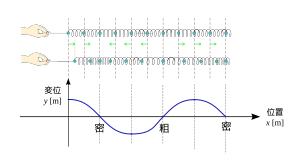Mechanical wave facts for kids
Imagine you're at the beach, and you see waves crashing. Or maybe you're talking to a friend, and sound travels between you. These are all examples of mechanical waves. A mechanical wave is a special kind of wave that needs something to travel through. This "something" is called a transmission medium.
Think about it:
- Sound waves need air, water, or a solid object to move.
- Waves in the ocean need water.
- Waves in a Slinky toy need the Slinky itself.
Without a medium, mechanical waves cannot exist. They are different from waves like light, which can travel through empty space.
Contents
What Are Mechanical Waves?
Mechanical waves are like a chain reaction. When a mechanical wave moves, the material it travels through doesn't actually move along with the wave. Instead, the material just wiggles back and forth in its spot. It's like a crowd doing "the wave" at a sports game. People stand up and sit down, but they don't move around the stadium.
How Mechanical Waves Move Energy
The most important thing about mechanical waves is that they carry energy, not material. The energy travels from one tiny particle of the medium to the next. Each particle passes the energy along, then returns to its original place. This is how the wave travels, even though the medium itself stays put.
Key Features of Mechanical Waves
Like all waves, mechanical waves have several important features:
- Frequency: This is how many waves pass a point in a certain amount of time.
- Period: This is the time it takes for one complete wave to pass a point.
- Wavelength: This is the distance between two matching points on a wave, like from one peak to the next peak.
- Amplitude: This is the height or strength of the wave. A bigger amplitude means more energy.
Images for kids
See also
 In Spanish: Onda mecánica para niños
In Spanish: Onda mecánica para niños



